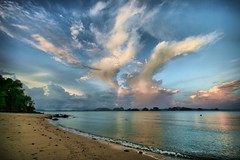Hi Friends! Our last day in Thailand! Now we are in Phuket and tomorrow we flight back to Munich in Germany for other 2 days and then back home.
My Most interesting photos for a guy called Isaias
Ko Yao (Thai: เกาะยาว) is a district (Amphoe)
Ko Yao (เกาะยาว), sometimes written Koyao, is a group of islands between Phuket and Krabi. There are two main islands, Ko Yao Noi ("Small Long Island") and Ko Yao Yai, with Noi being the more developed of the two.
Ko Yao Noi remains a beautiful island, where most people still believe that the island should be preserved from human degradation.
Sea Gypsies (Moken people) were inhabiting the Bay before anybody else, except maybe other nomadic people like forest hunters and collectors (Sakai, Negritos). The 3,500 or so inhabitants of Koh Yao Noi are thought to be recent migrants from the Malay Peninsula (Satun, Trang).
The Mon population, linguistically and culturally belonging to the Khmer ethnolinguistic group, did settled in peninsular Thailand since ever, ruling maritime states like the one of Ligor (Nakhon Si Thammarat). They melt continuously with Southern migrants from Malaysia and with Northern rulers (Thai), over centuries of commercial exchanges and political conflicts. Most probably the Mon stock remains prevalent for most of the people living nowadays in Southern Thailand, including people of Koh Yao.
Numerous cave paintings hidden in the many islands of the bay, extending from 2000 years ago to last century, attest the influence of distinct communities in the emergence of a mixed origin population, living now in the provinces of Phang Nga, Phuket, Krabi and Satun.
The most recent migrations (17th-18th century) from Satun and Trang to Ko Yao Yai and Koh Yao Noi is attested by the fact that the particular dialect spoken on the island still bear obvious Malaysian lexical traces, particularely regarding toponyms and vernacular names of the flora species.
The main industries on the island are fishing and rubber planting. A little rice farming and some fruit, palm and coconut plantations are evident. Boat building and farming techniques here have been passed from father to son and, while some of the youngsters leave Ko Yao to seek the bright lights of Phuket, most return to their tight knit community
From: en.wikipedia.org/wiki/Amphoe_Ko_Yao
...........................
:))
Thanks Angela Lobefaro
Apr 18, 2009
Subscribe to:
Post Comments (Atom)





No comments:
Post a Comment